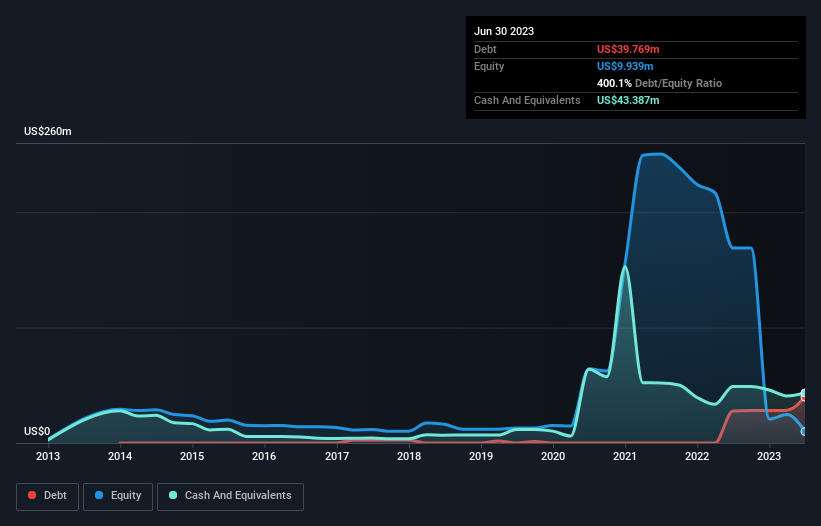David Iben put it well when he said, 'Volatility is not a risk we care about. What we care about is avoiding the permanent loss of capital.' So it seems the smart money knows that debt - which is usually involved in bankruptcies - is a very important factor, when you assess how risky a company is. As with many other companies GAN Limited (NASDAQ:GAN) makes use of debt. But the more important question is: how much risk is that debt creating?
Why Does Debt Bring Risk?
Debt is a tool to help businesses grow, but if a business is incapable of paying off its lenders, then it exists at their mercy. Ultimately, if the company can't fulfill its legal obligations to repay debt, shareholders could walk away with nothing. However, a more usual (but still expensive) situation is where a company must dilute shareholders at a cheap share price simply to get debt under control. By replacing dilution, though, debt can be an extremely good tool for businesses that need capital to invest in growth at high rates of return. The first step when considering a company's debt levels is to consider its cash and debt together.
Check out our latest analysis for GAN
How Much Debt Does GAN Carry?
The image below, which you can click on for greater detail, shows that at June 2023 GAN had debt of US$39.8m, up from US$27.7m in one year. But on the other hand it also has US$43.4m in cash, leading to a US$3.62m net cash position.

A Look At GAN's Liabilities
Zooming in on the latest balance sheet data, we can see that GAN had liabilities of US$32.3m due within 12 months and liabilities of US$52.8m due beyond that. On the other hand, it had cash of US$43.4m and US$10.2m worth of receivables due within a year. So its liabilities outweigh the sum of its cash and (near-term) receivables by US$31.5m.
This deficit is considerable relative to its market capitalization of US$50.0m, so it does suggest shareholders should keep an eye on GAN's use of debt. Should its lenders demand that it shore up the balance sheet, shareholders would likely face severe dilution. While it does have liabilities worth noting, GAN also has more cash than debt, so we're pretty confident it can manage its debt safely. When analysing debt levels, the balance sheet is the obvious place to start. But ultimately the future profitability of the business will decide if GAN can strengthen its balance sheet over time. So if you're focused on the future you can check out this free report showing analyst profit forecasts.
In the last year GAN wasn't profitable at an EBIT level, but managed to grow its revenue by 2.1%, to US$138m. We usually like to see faster growth from unprofitable companies, but each to their own.
So How Risky Is GAN?
Statistically speaking companies that lose money are riskier than those that make money. And in the last year GAN had an earnings before interest and tax (EBIT) loss, truth be told. Indeed, in that time it burnt through US$8.6m of cash and made a loss of US$172m. With only US$3.62m on the balance sheet, it would appear that its going to need to raise capital again soon. Summing up, we're a little skeptical of this one, as it seems fairly risky in the absence of free cashflow. When analysing debt levels, the balance sheet is the obvious place to start. However, not all investment risk resides within the balance sheet - far from it. For instance, we've identified 4 warning signs for GAN that you should be aware of.
When all is said and done, sometimes its easier to focus on companies that don't even need debt. Readers can access a list of growth stocks with zero net debt 100% free, right now.
New: Manage All Your Stock Portfolios in One Place
We've created the ultimate portfolio companion for stock investors, and it's free.
• Connect an unlimited number of Portfolios and see your total in one currency
• Be alerted to new Warning Signs or Risks via email or mobile
• Track the Fair Value of your stocks
Have feedback on this article? Concerned about the content? Get in touch with us directly. Alternatively, email editorial-team (at) simplywallst.com.
This article by Simply Wall St is general in nature. We provide commentary based on historical data and analyst forecasts only using an unbiased methodology and our articles are not intended to be financial advice. It does not constitute a recommendation to buy or sell any stock, and does not take account of your objectives, or your financial situation. We aim to bring you long-term focused analysis driven by fundamental data. Note that our analysis may not factor in the latest price-sensitive company announcements or qualitative material. Simply Wall St has no position in any stocks mentioned.
About NasdaqCM:GAN
GAN
Operates as a business-to-business (B2B) supplier of enterprise software-as-a-service solutions to iGaming and online sports betting applications in the United States, Europe, Latin America, and internationally.
Fair value low.
Similar Companies
Market Insights
Community Narratives



